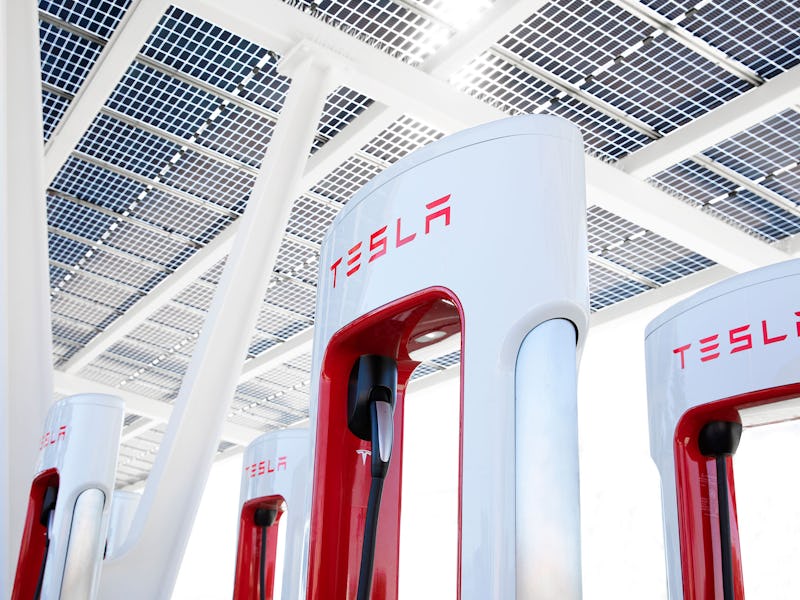How Tesla could dominate EV fast charging across America
Tesla is intent on expanding its Supercharger network, going so far as open-sourcing its charger to other EV makers.

Tesla looks like it’s planning on making its Supercharger design the fast charger of choice for most Americans. The company recently open-sourced its charging connector design in an attempt to get more people to adopt its standard.
Couple that with the fact that Tesla already has an extensive Supercharger network and it wouldn’t be a stretch to assume we’ll see far more Tesla charging stations in the future. Tesla’s CEO Elon Musk even recently responded to President Joe Biden’s Tweet that the U.S. would be building 500,000 EV charging stations across the country by urging people to buy a Tesla instead since it already has an extensive charging network.
Even though Tesla open-sourced its charging connector design, we don’t really know what it would look like if another EV maker adopted it. As for the charging network, you could argue that Tesla is already dominating the U.S. in terms of coverage. Here’s how Tesla could tighten its grip on America’s EV charging network.
HOW BIG IS TESLA’S SUPERCHARGER NETWORK?
Tesla’s Supercharger network is already the most extensive EV fast-charging network with more than 40,000 chargers spread across 4,400 stations throughout the world. Tesla has stationed more than a third of them in North America (almost 1,500 in the U.S.), another third in Asia, and the remainder in Europe.
Tesla had a huge headstart building out its Supercharger network.
While President Biden’s Tweet mentioned that you would be able to do the “great American road trip” on a fully electric EV, Musk rebutted, stating that you can already do so with a Tesla. Besides Tesla’s Supercharger, there are only two other options: Combined Charging System (CCS) charging or CHAdeMO charging that’s mostly used by Japanese automakers.
WHY DID TESLA OPEN-SOURCE ITS CHARGER?
In the second part of Musk’s response to Biden’s Tweet, he noted that Tesla open-sourced its charging connector to allow other EV makers and charging station owners to adopt it. The move keeps Tesla even more competitive with the growing CCS standard that’s used by major automakers like BMW, Ford, Hyundai, Rivian, and others. Tesla even rebranded its charging connector as the North American Charging Standard, or NACS for short, which sounds pretty similar to CCS.
Tesla’s charging connector was made open-source and will be known as the North American Charging Standard.
It’s clear Tesla wants to maintain its position as the most accessible charging connector, even if it’s hard to imagine automakers who are in direct competition with Tesla adopting its charging standard. That being said, Tesla states in its blog post that its NACS chargers are “half the size and twice as powerful” when compared to CCS chargers.
That difference in efficiency may be enough to persuade some automakers to switch over.
There’s also another potential benefit to Tesla opening up its charging design: money. As noted by Electrek, if Tesla gets even one automaker to use NACS, it would qualify the EV titan for federal funding to expand its Supercharger network.
At this point, opening up its charging standard could be a savvier business move than keeping competitors locked out of its formidable charging network.
WILL TESLA’S DECISION TO OPEN-SOURCE NACS BENEFIT OTHER EVS?
While increasingly less of a nightmare, charging infrastructure in the U.S. is still woefully inadequate for many motorists. That means the ability to use Tesla’s network could make owning an EV a lot more convenient. According to Tesla, its chargers currently outnumber CCS stations run by companies like Electrify America by a ratio of 2 to 1.
Whether Tesla’s competitive advantage will be enough to convince other EV brands to adopt its charger is another story entirely. The EV market is increasingly saturated, making competition fiercer than ever — not exactly the best environment for cross-brand collaboration. Still, the best, most effective tech usually wins in the end, and right now Tesla has a leg up.
This article was originally published on